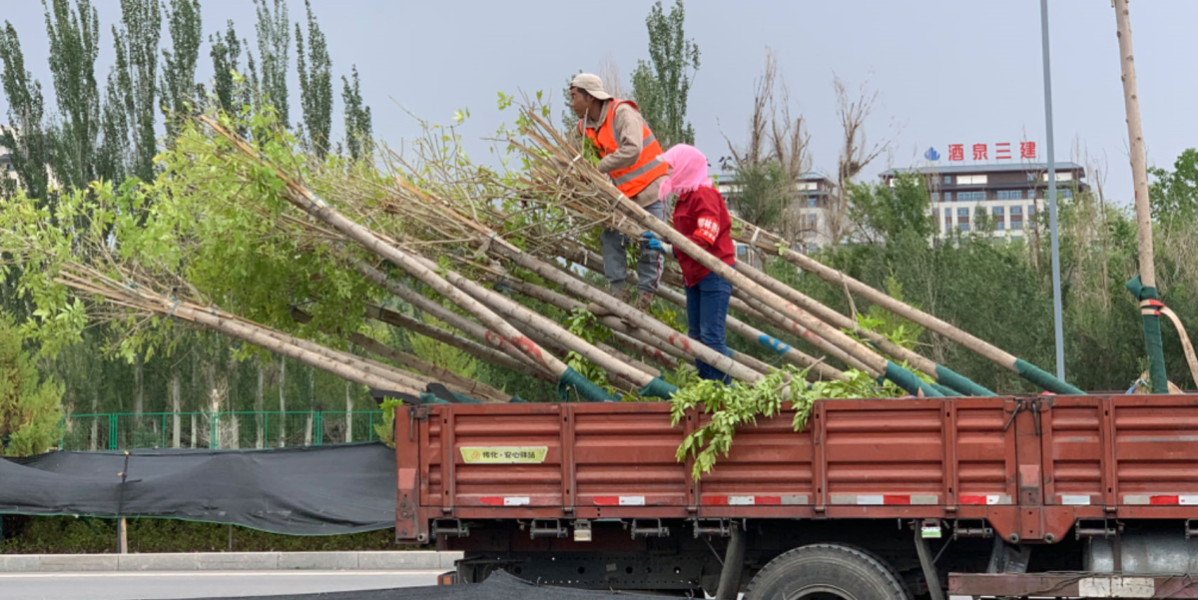East Asia Blog Series
How Integrated Urban Solutions Build Inclusive, Sustainable, and Climate-Resilient Cities
Lan Wang 18 Sep 2023
An integrated approach to sustainable and inclusive development helps an oasis city in the People’s Republic of China overcome environmental challenges.
Overview
Jiuquan was an oasis on the ancient Silk Road along the Hexi Corridor, an important trade route in the northwestern region of the People’s Republic of China (PRC). Located between the southern limits of the Gobi desert and the Qilian Mountains, this city in Gansu province has faced development challenges because of its harsh natural environment. Yet, it has a thriving economy, and it is expected to play a strategic role in the socioeconomic development of the region.
A project funded by the Asian Development Bank (ADB) supported Jiuquan city by implementing an integrated solution to promote environmentally sustainable and inclusive development through improvements in wastewater management, urban transport and related facilities, windbreak plantation, and other services. Climate change mitigation and adaptation measures were introduced in the project design to strengthen the city’s climate resilience and reduce carbon emissions.
The project also strengthened the capacity of the municipal government for sustainable urban planning and development.
Project information
Project snapshot
- Approval date: 14 Jun 2013
- Closing date: 18 May 2021
- Total project cost: $202.19 million
- Executing agency: Jiuquan Municipal Government, Gansu Province, People’s Republic of China
- Financing: Asian Development Bank
Context
Jiuquan is located about 730 kilometers (km) northwest of the provincial capital of Lanzhou. The city’s key industries are renewable energy equipment manufacturing and agricultural product processing. Tourism has increasingly contributed to the city’s economic output based on its rich historic and cultural resources, as well as its status as the launching site of the national space program.
The city has the potential to serve as a vital artery for the relatively less-developed northwestern region of the PRC. The National Strategy for Development of the Western Region sees the city as having a key role in aiding the region’s socioeconomic development.
Challenge
Jiuquan faces various environmental problems and urban development challenges. It has a continental desert climate with constrained water resources and high evaporation. Sand and dust are carried frequently by strong winds from the desert, causing atmospheric pollution, a high incidence of respiratory illness, and productivity losses.
Beida, the river that flows through Jiuquan, has been gradually polluted by discharges of untreated wastewater from the city. Its water quality is class II for the upstream reach of Jiuquan, class III through the city area, and class IV downstream.[1]
As a water-scarce city undergoing continuous growth, Jiuquan must stem the gradual contamination of its water resources, which endangers public health and safety and constrains its sustainable development.
The increasingly congested urban roads and inadequate infrastructure also limit the city’s ability to promote greater links along the Hexi Corridor and enable socioeconomic development in the northwestern region.
Solutions
The project supported the city in addressing its challenges through an integrated approach to improving the urban environment and by involving the local community in project design and implementation.
Expand windbreak tree screens. About 60.5 hectares (ha) of windbreak tree screens were planted along the northern and southern banks of the Beida River to reduce the city’s vulnerability to desertification, enhance public amenities, and improve the living environment and public health of residents.
A windbreak plantation education trail was set up to improve public awareness where visitors can learn about the city’s exposure to desertification, the challenges that Jiuquan faces in managing its water resources and air quality, and the benefits of afforestation in protecting the environment and improving the city’s resilience to climate change impacts.
Improve wastewater management and resources reuse. A wastewater treatment plant with a capacity of 60,000 cubic meters (m3) per day and a wastewater collection network with a total length of 44.2 km were constructed. About 18,000 m3 of reclaimed water is used daily for greening and irrigation of the windbreak plantation. Reclaimed water reuse will be increased to 30,000 m3 around 2025. Sludge after dewatering with water content below 60% is disposed to a sanitary landfill. A road map for sludge reuse—such as land improvement, soil conditioner for the windbreak trees plantation, or other agricultural uses, was developed and will be implemented in the near future.
Improve urban road network and facilities. In the expanded urban area, about 15.7 km of roads and two bridges were constructed and upgraded. Associated utility facilities , such as road lighting, pipes for water supply, wastewater, heating, and gas, and conduits for electricity and telecommunication lines, were installed. In the existing central urban area, traffic management and safety systems and 0.8 km of roads were upgraded.
Develop the municipal government’s capacity in urban planning and management. The project trained officials of Jiuquan municipal government and staff of the project implementing agencies in various aspects of urban planning and management. It developed and enhanced plans and strategies in water conservation, wastewater reuse, sludge management, urban transport system, traffic management and safety, and desertification risk management. It also promoted private sector participation to improve the efficiency of municipal services.
Promote local communities’ participation in project design and implementation.
Different groups of local communities were widely consulted to improve road design. Improvements included traffic lights; pedestrian crossings to ensure road safety, especially for children and older persons; and optimization of routes, frequencies, and hours of service as well as links to school and health services before new bus services were put into place.
Representatives were invited to participate in public hearings for wastewater and water tariffs to improve transparency. Water conservation advocacy campaigns were organized annually and delivered through public broadcasts, television, newspapers, the internet, brochures, booklets, billboards, and documentaries, reaching more than 100,000 beneficiaries to improve public awareness and behavior to support saving of water resources.
Results
Improved living conditions and urban infrastructure services.
About 450,800 residents, 218,100 (48%) of them women and 11,333 from low-income households, directly benefitted from the project. They have sustainable access to an improved road network and related services, wastewater management, and landscaped windbreak plantations.
There is now a road linking the high-speed railway station and the Western Suburbs Industrial Zone, reducing travel time at peak hours between the two spots to 25 minutes from 45 minutes. Improved traffic management contributed to substantial reduction in traffic fatality rate to less than 2.5 per 10,000 vehicles from 4.5.
The project provided windbreaks for the city against sandstorms, enhanced public amenities, and improved the living environment and public health of local residents, with additional benefits of carbon sequestration, sand fixation, secured agricultural production, soil conservation, and regulation of micro-climate.
Public satisfaction with the urban environment and ecology increased to 90.5% in 2020 from 84% in 2011.
Improved environment and climate resilience of the city.
The project generated significant environmental benefits. Wastewater collection and treatment rate increased to about 99% from 66%, pollutants discharge to the Beida River was dramatically reduced, and the water quality was improved to grade I from grade III.
Climate change mitigation and adaptation measures that were considered in the project design and carried out during implementation improved the city’s climate resilience. The windbreak forest created 10,104 tons of biomass, absorbed 2,678 tons of carbon dioxide, and released 1,983 tons of oxygen each year. The mitigation measures will gradually reduce the risk of increasing desertification in the long term. The bridges and associated culverts were designed as an adaptive measure against road flooding during torrential rain or heavy flooding with a 1-in-100-year return period. The reuse of the treated wastewater for greening and irrigating the windbreak forests was also an adaptive measure to conserve water resources.
Improved institutional capacity. The Jiuquan municipal government improved its institutional capacity in urban development planning. The strategies developed under the project became part of the city’s integrated long-term development plan.
Water sector management and governance were strengthened through enhanced water conservation and reuse and establishment of private–public partnership.
Public utilities improved their capacity in project design and implementation and assets management, and incorporated the inclusive participatory consultations with various stakeholders, including residents, into their operations.
Lessons
The project designed and implemented a comprehensive capacity building component that strengthened the municipal government’s institutional capacity in forming strategies for water conservation, resources reuse, traffic management and traffic safety improvement, and desertification risk management. This enhanced the project’s sustainability.
The inclusive and participatory approach in project design promoted social inclusion and equitable access to urban services.
To address the emerging challenges posed by climate change, mitigation and adaptation measures could be considered in the project design and carried out during implementation to improve a city’s resilience to impacts.
[1] The Water Quality Standards (GB 3838-2002) of the People’s Republic of China have five classes. Class I is pristine; class II is for high-value fish production areas and spawning habitats; class III is suitable for urban water supply; class IV is suitable for irrigation and recreation; and class V is polluted and not recommended for human consumption or agricultural use.
References
Asian Development Bank (ADB). 2022. Completion Report: Gansu Jiuquan Integrated Urban Environment Improvement Project in the People’s Republic of China. Manila.
ADB. 2013. Report and Recommendation of the President to the Board of Directors: Proposed Loan People’s Republic of China: Gansu Jiuquan Integrated Urban Environment Improvement Project. Manila.
Author

Lan Wang
Senior Project Officer, East Asia Department, ADB
This blog is reproduced from Development Asia.


